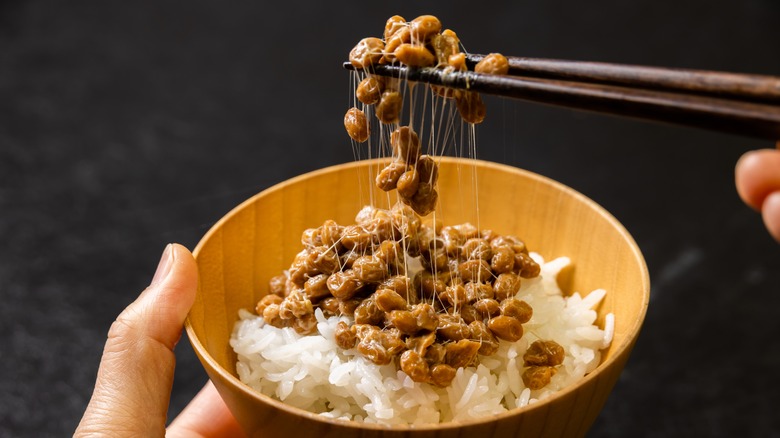What Makes Natto So Sticky?
Nattō is a strange and wonderful thing. Yes, it does have a distinct pungent aroma and is a bit slimy, but it packs a crazy nutritional punch. Its white, sticky tendrils — though potentially off-putting — are actually part of what makes nattō so healthy. But why is this soybean dish so sticky? It's due to the polyglutamic acid that is produced during the fermentation process used to make nattō. What is polyglutamic acid? It's a wondrous polypeptide that not only imparts a delicious umami flavor, but is also a little bit magical in its healing and nutritional powers.
Nattō is a staple in Japanese cuisine. It's often eaten with rice as part of breakfast, sometimes with an egg yolk on top, but can be enjoyed as a side dish or even as a snack on its own. Japan has one of the world's highest life expectancies, and it's no surprise that this is due largely to the staple foods in the Japanese diet — nattō among them.
The power of polypeptides
If you're unfamiliar with nattō, it's simply fermented soybeans. There are two types: Itohiki nattō, which is fermented without salt for a short period (typically 24 hours); and daitokuji nattō, which is inoculated with mold and salted, usually fermenting for half a year. During fermentation, the polypeptide polyglutamic acid is developed. This peptide is responsible for nattō's long white strings and is composed of short-chain amino acids.
You may be familiar with polyglutamic acids — but not in your food, but rather in your skincare routine. Polyglutamic acid is used in many skincare products as it is a humectant; it can hydrate your skin similarly to hyaluronic acid by pulling in moisture from your environment. Glutamate doesn't just help the appearance of your skin, it's what makes foods like nattō taste good by creating umami flavors (you can take a wild guess what the 'G' in MSG stands for).
Eat natto, live forever
Nattō can be a bit of an acquired taste. According to the BBC, a study conducted in 2017 by a Japanese internet service concluded that only 62% of the population of Japan actually likes nattō, with 25% of participants being ambivalent about the flavor but eating it for its health benefits, and 13% of people surveyed disliking the stuff entirely. It's true that the flavor of nattō can be overwhelming; after all, it is fermented and can come across a bit like ammonia at first sniff.
There are so many reasons to add fermented food to your diet – if you're looking for something that's also packed with protein and anti-inflammatory properties, nattō might be the answer. According to the NIH, soy protein has been proven to reduce oxidative stress in the body, which can slow signs of aging and actually have anti-carcinogenic properties. The polypeptides in nattō are also able to reduce allergy symptoms such as dermatitis and asthma, as well as lower blood pressure. If you eat enough of this stuff you may just live to be 100.


